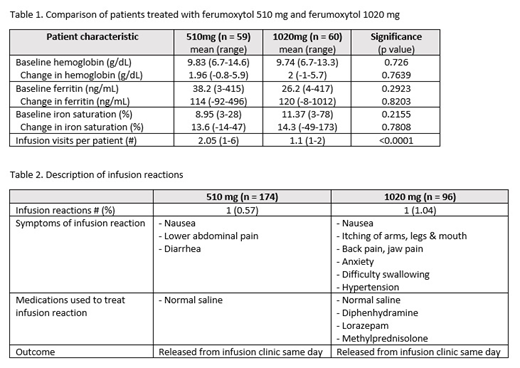
Background
Ferumoxytol (Feraheme) is an intravenous (IV) formulation of iron that can be infused quickly, making it a convenient choice. It is typically given in two doses of 510 mg. Auerbach and colleagues previously described utilizing a single dose of 1020 mg over 15 minutes safely and effectively (Am J Hematol 2013). A total dose infusion of 1020 mg has been described by experts in the field as the "maximum safe dose" (Auerbach and Adamson, Am J Hematol 2016). There exists very little published literature about the safety and efficacy of this off-label dosing, however it is an attractive administration schedule due to convenience of the one-time dose. In July 2018, we began to administer a single 1020 mg dose of feumoxytol to patients diagnosed with iron deficiency at the North Florida/South Georgia Veterans Health System (NF/SG VHS). The purpose of this review is to evaluate the impact of the use of the 1020 mg ferumoxytol dose to ensure safe, effective and efficient utilization in the management of iron deficiency anemia.
Methods
A retrospective chart review was conducted on patients who received ferumoxytol from February 1st, 2018 to January 31st, 2019 to capture approximately 6 months of data prior to and after the dosing strategy change. Patients were excluded from review if they had received IV iron within 3 months prior to the study period. Parameters collected included pre and post hemoglobin, iron saturation and ferritin concentrations, dose of iron given, frequency and number of infusions, post infusion monitoring time and hypersensitivity reactions. Our primary outcome was assessing safety, particularly the rate of infusion reactions for the entire cohort of patients. Secondary outcomes included efficacy and clinic utilization. Number of clinic visits, baseline and change in hemoglobin, ferritin and iron saturation following 1 dose of 1020 mg or 2 doses of 510 mg were compared using paired t tests. Rate of infusion reactions was compared between all patients who received either dose using Fisher's exact test.
Results
A total of 212 patients were screened and 140 included in analysis. 270 total doses of iron were given during the study period. Fifty nine patients (42%) received only 510 mg doses, 60 (43%) received only 1020mg doses and were included in the efficacy analysis. An additional 21 patients (15%) received both 510 mg and 1020 mg doses and were included in the analysis of reaction rate. Baseline characteristics were similar between the groups (see Table 1). Response to iron infusions were not significantly different between the dosing strategies. Mean change in hemoglobin was 1.96 g/dL for 510 mg group and 2.00 g/dL for the 1020 mg group (p=0.726). Mean change in ferritin was 114 ng/ml and 120 ng/ml, respectively(p=0.8203). Likewise, mean change in iron saturation was 13.6% and 14.3% (p=0.7808). The rate of infusion reactions was not increased with the higher dose (see Table 2), with only 1 reaction occurring in each group (0.57 % and 1.04 %, p=1.00). Both infusion reactions were able to be treated on an outpatient basis and the patients were discharged from the infusion clinic on the same day. Utilizing the 1020 mg dose significantly reduced the number of infusion room visits required, with an average of 2 visits for 510 mg patients and 1 visit for 1020 mg patients (p<0.0001).
Conclusion
Implementation of a total dose infusion of 1020 mg of ferumoxytol reduced the number of infusion room visits without increasing infusion reactions or compromising efficacy. This strategy could be considered at other institutions to improve infusion room access, patient convenience, and reduce costs.
Off label discussion concerns use of a one time dose of 1020mg of ferumoxytol as opposed to the labeled dose of 510 mg followed by a second dose 3 to 8 days later.
Author notes
Asterisk with author names denotes non-ASH members.

This icon denotes a clinically relevant abstract


This feature is available to Subscribers Only
Sign In or Create an Account Close Modal